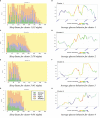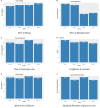Evaluating the influence of sleep quality and quantity on glycemic control in adults with type 1 diabetes
- PMID: 36896174
- PMCID: PMC9989462
- DOI: 10.3389/fendo.2023.998881
Evaluating the influence of sleep quality and quantity on glycemic control in adults with type 1 diabetes
Abstract
Background: Sleep quality disturbances are frequent in adults with type 1 diabetes. However, the possible influence of sleep problems on glycemic variability has yet to be studied in depth. This study aims to assess the influence of sleep quality on glycemic control.
Materials and methods: An observational study of 25 adults with type 1 diabetes, with simultaneous recording, for 14 days, of continuous glucose monitoring (Abbott FreeStyle Libre system) and a sleep study by wrist actigraphy (Fitbit Ionic device). The study analyzes, using artificial intelligence techniques, the relationship between the quality and structure of sleep with time in normo-, hypo-, and hyperglycemia ranges and with glycemic variability. The patients were also studied as a group, comparing patients with good and poor sleep quality.
Results: A total of 243 days/nights were analyzed, of which 77% (n = 189) were categorized as poor quality and 33% (n = 54) as good quality. Linear regression methods were used to find a correlation (r =0.8) between the variability of sleep efficiency and the variability of mean blood glucose. With clustering techniques, patients were grouped according to their sleep structure (characterizing this structure by the number of transitions between the different sleep phases). These clusters showed a relationship between time in range and sleep structure.
Conclusions: This study suggests that poor sleep quality is associated with lower time in range and greater glycemic variability, so improving sleep quality in patients with type 1 diabetes could improve their glycemic control.
Keywords: clustering techniques; glucose behavior prediction; glycemic control; sleep structure; statistical analysis.
Copyright © 2023 Botella-Serrano, Velasco, Sánchez-Sánchez, Garnica and Hidalgo.
Conflict of interest statement
The authors declare that the research was conducted in the absence of any commercial or financial relationships that could be construed as a potential conflict of interest.
Figures




References
Publication types
MeSH terms
Substances
LinkOut - more resources
Full Text Sources
Medical

